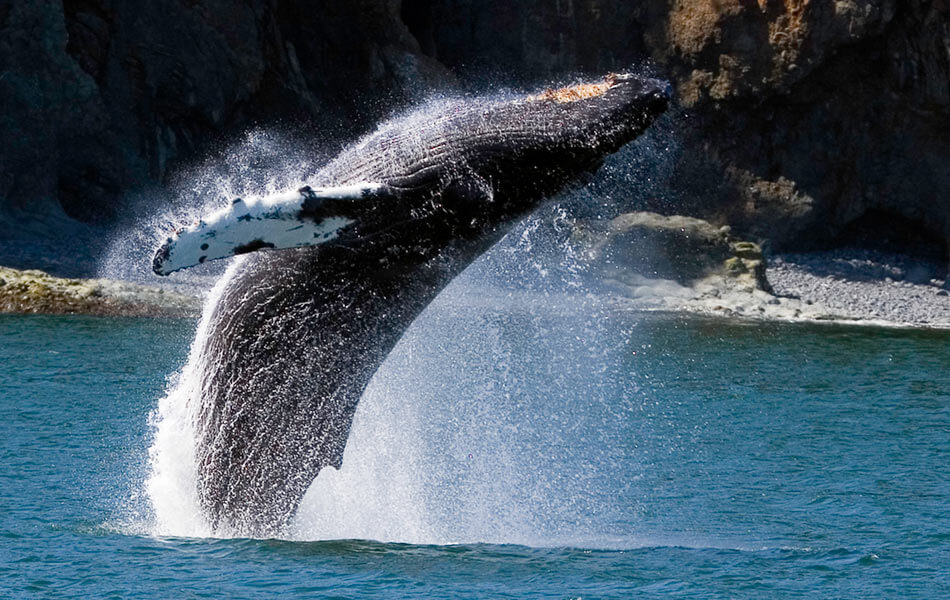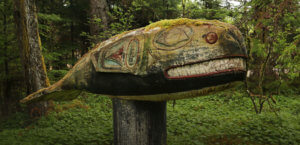
All Hail the Mighty Whale!
From the Old Testament story of Jonah and the whale to Melville’s Moby Dick, humans have long been fascinated by the mighty whale. Spotting whales is one of the most awe-inspiring parts of everyone’s Inside Passage adventure. Even though it’s winter, Alaska’s magnificent marine mammals are on our minds because this Sunday, February 15 is World Whale Day. Begun in Maui in 1980, the day is an opportunity not only to appreciate these phenomenal sea creatures, but also to remain mindful of the challenges facing our oceans and the species that live in them.
At Alaskan Dream Cruises, we depend on healthy ecosystems in our waters and we’re committed to sustainability and environmental respect. We practice responsible consumption and waste reduction. For example, we’ve eliminated single-use plastics both on-shore and off, we’ve invested in environmentally conscious linens and towels, and we’ve fully equipped the newest member of our fleet, the Kruzof Explorer, with solar panels. These efforts to reduce our carbon footprint are ongoing and vital to the future of the waters, landscapes and communities of Southeast Alaska.
 Native Languages of the Americas says the orca, also sometimes called blackfish, is an important medicine animal to many Native clans. “Killer whales are considered a particular symbol of power and strength, and catching sight of one is considered a momentous omen. Some tribes, such as the Tlingit, view the killer whale as a special protector of humankind and never hunted killer whales (although they were accomplished whale hunters of other species.)” The group, which is dedicated to the preservation of Native languages and customs, goes on to say that killer whales are also used as a clan animal in some Native American cultures including Alaska’s Tlingit and Tsimshian tribes.
Native Languages of the Americas says the orca, also sometimes called blackfish, is an important medicine animal to many Native clans. “Killer whales are considered a particular symbol of power and strength, and catching sight of one is considered a momentous omen. Some tribes, such as the Tlingit, view the killer whale as a special protector of humankind and never hunted killer whales (although they were accomplished whale hunters of other species.)” The group, which is dedicated to the preservation of Native languages and customs, goes on to say that killer whales are also used as a clan animal in some Native American cultures including Alaska’s Tlingit and Tsimshian tribes.
Alaska is home to a number of whale species, including gray whales and belugas, but on our myriad itineraries you’re most likely to see humpbacks and killer whales, also known as orcas. Fun fact, though: Orcas, which can grow to more than 30 feet long, are actually dolphins! Whales, dolphins and porpoises are known as cetaceans, which are aquatic mammals that are broken down into two groups — baleen and toothed.
Baleen whales have no teeth. Instead, they have a filter feeding system in their mouths which allows them to feed on krill, shrimp and other small fish. They also have two blowholes. The humpback is a baleen whale.
Toothed whales, like orcas, have just one blowhole. The National Oceanic and Atmospheric Administration says resident killer whales in Alaska feed exclusively on fish, mainly salmon, while transient whales eat marine mammals and squid.
Alaska.org notes coastal Alaska is a feeding ground for about 10,000 humpbacks. “Up to 60-feet long and 40 tons in weight, humpbacks are fabled for singing eerie and intricate ‘songs’ while on their trans-Pacific journeys.” The whales breed in Hawaii during the winter and, in summer, can be spotted throughout our small-ship cruise itineraries in the Southeast part of the state. Meanwhile, resident killer whales remain in Alaska waters throughout the year.
Many travel publications have lauded Alaska as a destination for whale watching enthusiasts. “Juneau is the best spot for whale watching in Alaska,” according to Thrillist. Travel & Leisure notes humpbacks and orcas can be seen around Juneau between April and December, while the travel website Escape Here says Alaska is the #1 whale watching destination in the world – “and photo opportunities are endless.”
One of the advantages of a small-ship cruise is the opportunity to see whales and other wildlife in a more personalized way. Our vessels can access remote inlets and coves where larger ships simply cannot go, making it far more likely to get a good, up-close look. Itineraries like our Alaska’s Islands, Whales & Glaciers are very fluid, with crew customizing each voyage based on migration patterns, passenger interests and weather. Check out all of our excursions and ships, and be sure to take a look at our specials for discounts, perks and upgrades available through the end of February 2020. You’ll have a whale of a time, so don’t forget those binoculars and cameras!


